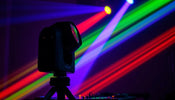
Can You Sync Moving Head Lights With Music?
, by Katy Chen, 10 min reading time

, by Katy Chen, 10 min reading time
Yes, you can definitely sync moving head lights with music! There are two main ways to do it: an easy, automatic method called Sound-Active Mode, and a more powerful, professional method using DMX programming. Whether you're setting up lights for a small home party or planning a professional stage production, synchronizing your moving head lights with music creates an immersive experience that elevates any performance.

Sound-Active Mode is the simplest way to sync your moving head lights with music. Think of it as giving your lights ears! Each light fixture has a built-in microphone that "listens" for a beat (usually the bass drum) and triggers a built-in movement or color change when it detects one.
This method requires virtually no setup or technical knowledge. You simply turn on your moving head lights, activate the sound mode (usually with a button on the fixture or remote), and the lights automatically respond to your music's rhythm.
Sound-Active Mode works best in smaller spaces where the microphone can clearly pick up the music. For home parties, small DJ gigs, or casual events, this method provides an easy way to add dynamic lighting that responds to your music without any complicated setup.

DMX Programming is how all professional light shows are created. This method gives you complete creative control over every aspect of your moving head lights, allowing for precise synchronization with specific moments in your music.
Instead of the light guessing when to change based on sound, you become the director. You use a DMX controller to create specific looks (we call them "scenes" or "cues"). Then, as the lighting operator, you trigger those cues manually in time with the music, or program them to run in a timed sequence.
DMX (Digital Multiplex) is the industry standard protocol for controlling professional lighting. Each light receives specific commands through a DMX cable, telling it exactly what color, position, movement pattern, and effect to display at any given moment.

For DJs, bands, churches, and professional events, DMX programming is worth the investment. The level of precision and professionalism it brings to your lighting creates an immersive experience that truly enhances your music and captivates your audience.
| Feature | Sound-Active Mode | DMX Programming |
|---|---|---|
| Ease of Use | Very easy, plug-and-play | Moderate learning curve |
| Setup Time | Minutes | Hours initially, minutes for repeat shows |
| Creative Control | Limited to built-in programs | Complete control over all parameters |
| Synchronization Quality | Basic, sometimes random | Precise, professional |
| Additional Equipment | None | Controller, cables, possibly software |
| Best For | Home parties, small venues, beginners | Professional events, bands, clubs, churches |
For those looking to take their lighting to the absolute highest level, there's timecode synchronization. This advanced technique is what major concert tours and professional productions use to create perfectly synchronized light shows that run identically every time.
With timecode, a digital signal embedded in or running alongside your audio track automatically triggers pre-programmed DMX cues at precise moments. This means your entire light show can run automatically in perfect sync with the music, without needing a live operator to trigger cues manually.
While timecode synchronization requires specialized software, hardware, and significant programming time, it represents the ultimate goal for many lighting designers. For touring shows, theatrical productions, or permanent installations, this method ensures flawless synchronization between moving head lights and music every single time.
Whether you're just starting out with sound-active mode or ready to dive into DMX programming, synchronizing your moving head lights with music creates an incredible atmosphere that transforms any event. You can start simple and gradually build your skills toward more professional setups as you grow.

At Any Case Gear, all our moving heads support both sound-active and DMX modes, giving you the flexibility to start simple and grow into more advanced techniques. Our expert team can help you choose the right equipment for your needs and budget.
Explore Our DMX-Ready Lighting CollectionHave questions about creating your first DMX setup or need a quote? Our expert team is always ready to help on WhatsApp.
Ask an Expert on WhatsApp